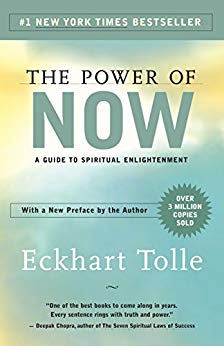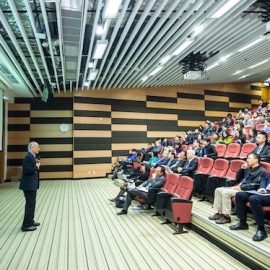

This article is an excerpt from the Shortform summary of "The Power of Now" by Eckhart Tolle. Shortform has the world's best summaries of books you should be reading.
Like this article? Sign up for a free trial here .
How much time do you spend thinking about things besides what is happening in the present moment? Are you always consumed in thought to the neglect of what is happening in your immediate awareness?
When you are living on autopilot, you are in a state of unconsciousness. Living in a state of unconsciousness prevents you from experiencing the bliss of who you are—your true being. Instead, it makes you identify with your ego (the thinking self) and prevents you from really connecting with everything and everyone around you.
Here is how living on autopilot eats away from your happiness and how being present can help you stop this unhealthy, self-sabotaging tendency.
Waking Unconsciousness
When you are living on autopilot, you are in a state of unconsciousness. There are two forms of unconsciousness: ordinary unconsciousness and deep unconsciousness.
Ordinary unconsciousness is a normal state for someone who identifies with her ego, with a consistent low-level of unease, discontent, boredom, or nervousness. This is like the hum of an air conditioner, a subtle background noise that you don’t notice until it stops.
Deep unconsciousness is more acute and painful. This is when the panic alarm goes off — when problems arise in life, you face a conflict in a relationship, or the ego is significantly threatened.
Deep unconsciousness inspires intense anger, fear, aggression, depression and other negativity, causing our more extreme actions like physical violence.
- Deep unconsciousness can happen more easily when there is a crowd or community of people who create negative collective energy (think of phenomena like mob mentality).
If you are already experience ordinary unconsciousness in day-to-day circumstances, challenges will typically intensify that to a level of deep unconsciousness. In other words, if you struggle to be present when life is calm, how will you do it when stress and chaos ensue?
For this reason, it’s important to practice being present in day-to-day life when things are going relatively smoothly.
Nearly everyone is constantly consumed in thoughts, so it’s considered normal, and we don’t stop and realize how it is affecting us.
What Is Your True Being?
Living in the state of unconsciousness prevents you from experiencing the bliss of your True Being.
Your incessant thinking self leads you to believe that your identity must be steeped in the qualities that make you different from everyone around you. However, your true Being connects you with everyone and every living thing in the world.
Your true Being is your deepest self, which you can connect with only when you are present. Your Being is your life energy, which is unaffected by your physical body, your mind and ego, and any external factors.
The world is made up of life energy taking on physical forms (like humans, plants, animals). This means that every living thing has a true Being, and all Beings are connected by a unifying life energy. (Shortform note: This concept is very nebulous and difficult to grasp. Tolle acknowledges this, and says you can only grasp it by experiencing your true Being. He asks readers not to try to understand Being, but rather to feel it when they are present.)
Your Being is indestructible, even in the death of your physical body; it exists before you are born and lives on after your death. Think of your body as merely the physical form that your Being takes on. We should not get attached to the physical forms, because they are only temporary. (Shortform note: “Being” seems somewhat comparable to “soul,” though that word is never mentioned.)
Connecting with your Being is the only way to attain true happiness, and being present is the only way to connect with your true Being; you can’t have one without the other.
You can access presence and your Being only by shedding your ego-created thoughts and identity, which are responsible for your pain, fear, and unhappiness (We will explore this more in later sections). Thus, being present and connecting with your Being are the only routes to inner peace, joy, and true happiness.
How To Disconnect From Your Ego And See Your True Being
How do you disconnect from the voice inside your own head? It takes deliberate effort, attention, and practice.
You can begin to separate your true self from your egoic mind by observing your thoughts. This is called “watching the thinker.” Thoughts come from your ego, making your ego the “thinker.” The part of you that can observe your thoughts without engaging in them is the “watcher,” your true self.
Try this: think, “I wonder what my next thought will be.” Wait and watch. Notice that your thoughts will likely stall for a moment while you are in this state of presence and alertness. You’ve just watched the thinker.
When you can understand that the watcher and the thinker are separate, then you can realize that you are not made of your thoughts. In moments when your mind is still and thoughts are quiet, you still exist and are still yourself.
As soon as you witness your thoughts, you’ve separated yourself from them — even if only for a moment. This is a victory in itself.
As you are watching your thoughts, be mindful not to analyze or judge them. Those analytical or judgmental thoughts would be your ego slipping back in through the back door. Instead, simply observe.
As you start practicing, you will experience states of “no-mind” — also called presence or consciousness — when there is a pause in your thoughts and you are connected with your true self. (In contrast, when you are not present you are under your ego’s control and are stuck in your thoughts.) These moments will be brief at first, but will extend with more practice.
Although your thoughts are quiet when you are present, it is a state of alertness and awareness of the present moment and of your true Being.
- When you are present you feel peace and inner stillness, though this is not a trancelike state like meditation. You actually become more alert and aware because you are solely and intensely focused on the Now. Sounds become more distinct, colors are more vivid, and the world is clearer without the white noise of your internal monologue.
You can practice being present in your day-to-day life by putting your full attention on a routine, mindless task. Here are a few examples.
- When you walk up or down stairs, think about every step you take. Feel your body making every movement. Notice the warmth in your leg muscles. Pay attention to your breath.
- When you wash your hands, pay attention to the sound and feel of the water running over your hands. Focus on how you move your hands. Notice the smell of the soap. Feel the texture of the towel.
We are so accustomed to the ego’s control — and the low, constant hum of thoughts running through our mind — that it can be easy to overlook. To notice if you are present, ask yourself, “Am I feeling joy, ease, and lightness?” If the answer is no, then you are not present.
If that’s the case, you may not need to change what you are doing in that moment, but how you are doing it. Focus your complete attention on each minute detail of the task at hand to bring yourself back to the present.
———End of Preview———

Like what you just read? Read the rest of the world's best summary of "The Power of Now" at Shortform . Learn the book's critical concepts in 20 minutes or less .
Here's what you'll find in our full The Power of Now summary :
- Why you feel pain from the past, and how to get rid of it
- How to be more present and stop worrying about the future
- The 8 key ways to achieve mindfulness






